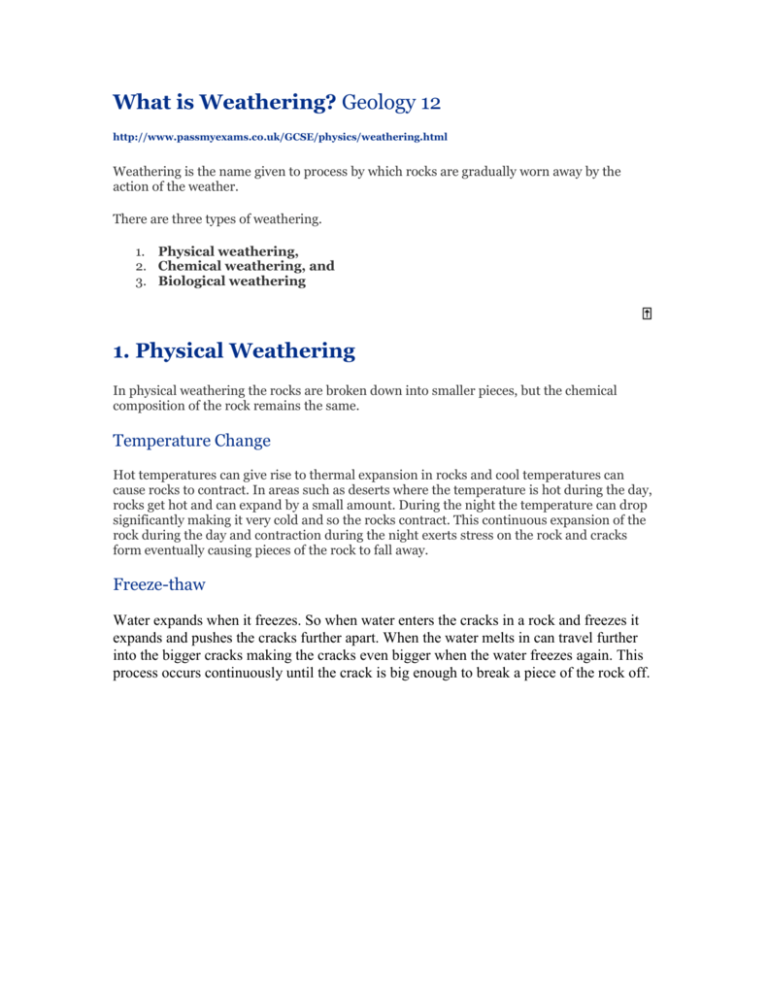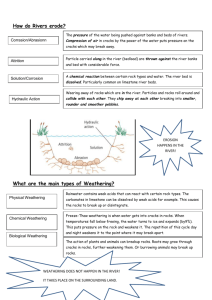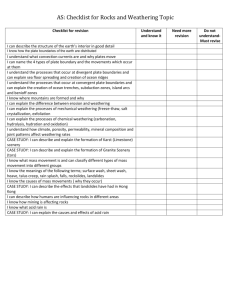Weathering Notes – Geology 12
advertisement

What is Weathering? Geology 12 http://www.passmyexams.co.uk/GCSE/physics/weathering.html Weathering is the name given to process by which rocks are gradually worn away by the action of the weather. There are three types of weathering. 1. Physical weathering, 2. Chemical weathering, and 3. Biological weathering 1. Physical Weathering In physical weathering the rocks are broken down into smaller pieces, but the chemical composition of the rock remains the same. Temperature Change Hot temperatures can give rise to thermal expansion in rocks and cool temperatures can cause rocks to contract. In areas such as deserts where the temperature is hot during the day, rocks get hot and can expand by a small amount. During the night the temperature can drop significantly making it very cold and so the rocks contract. This continuous expansion of the rock during the day and contraction during the night exerts stress on the rock and cracks form eventually causing pieces of the rock to fall away. Freeze-thaw Water expands when it freezes. So when water enters the cracks in a rock and freezes it expands and pushes the cracks further apart. When the water melts in can travel further into the bigger cracks making the cracks even bigger when the water freezes again. This process occurs continuously until the crack is big enough to break a piece of the rock off. Wind, Rain and Waves Wind can carry small particles or sand and rocks such as in sandstorms in deserts. When these particles collide with rocks they can wear them away. Rainfall can also wear away at rocks as can the action of waves over a long period of time. Wind The effects of weathering by wind can be seen on this rock formation at the Paria Canyon in Arizona, USA. Waves Located in Victoria, Australia these limestone pillars called the, “twelve apostles” have been created by the action of waves crashing against the limestone pillars. 2. Chemical Weathering Chemical weathering occurs when rocks are broken down by a chemical change. Rainwater can become slightly acidic by absorbing carbon dioxide in the atmosphere and this reacts with the mineral grains in the rock giving rise to new minerals and salts. The degree of chemical weathering depends on the type of rock for example limestone is more readily chemically weathered than granite. Other factors such as temperature also play a role as the chemical reactions occur more quickly in areas of high temperatures. Acid rain is also a contributor to chemical weathering. When fossil fuels such as coal, gas and gasoline are burnt they release oxides sulphur, carbon and nitrogen into the atmosphere. These gases combine with moisture in the air to form sulphuric acid, carbonic acid and nitric acid, making the resulting rainwater more acidic than normal. CHEMICAL WEATHERING The effects of chemical weathering in particular acid rain can be seen on this close up of this statues face. The acid rain has reacted with the mineral grain of the rock which has over time caused cavities to form as well wearing away the definition of the facial features. 3. Biological Weathering Biological weathering takes place when rocks are worn away by living organisms. Trees and other plants can grow within the cracks in a rock formation. As the roots grow bigger they push open cracks in the rocks making them wider and deeper. Over time the growing tree eventually prizes the rock apart. Tiny organisms like bacteria, algae and moss can grow on rocks and produce chemicals which can break down the surface layer of the rock. Burrowing animals such as rabbits can accelerate the formation of cracks. BIOLOGICAL WEATHERING This image shows biological weathering taking place by a tree whose roots have grown within a rock face. Weathering – the disintegration and decomposition of material at or near the surface. Mass wasting – the transfer of rock material downslope under the influence of gravity. Erosion – the incorporation and transportation of material by a mobile agent, usually water, wind, ice. Mechanical Weathering – Physical forces break rocks into smaller pieces that retain the same chemical composition of the parent material. Examples include: Frost action, Pressure, release, Thermal Expansion, Organic Activity Frost Action – Frost Wedging Wind Action Mechanical Weathering - Exfoliation Mechanical and Chemical weathering Chemical Weathering – Decomposition of a material to produce new minerals and ions. Agents include atmospheric gases, water and acid.. Oxygen dissolved in water oxidizes material. Carbon dioxide (CO2) dissolved in water forms carbonic acid and alters the material. Oxidation Caves







